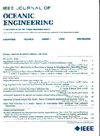一种基于多视图的浑浊遮挡水下场景能见度恢复方法
IF 5.3
2区 工程技术
Q1 ENGINEERING, CIVIL
引用次数: 0
摘要
在浑浊的水环境中,由于光线的散射和吸收,捕获的图像能见度差,对比度低,会导致图像退化。由于悬浮的宏观粒子,前景遮挡会进一步加剧这种情况。人工光源通常用于提高能见度,但使用单点光源,如聚光灯,会导致捕获的图像具有强背散射区域和低信号区域,对传统的水下图像恢复方法产生负面影响。为了解决这些挑战,我们引入了一种新的场景照明和扫描方法,该方法使用两个平行的发光二极管灯带和一个位于中心的单个摄像头,以确保均匀的场景照明和确定的分布模式。我们以合成孔径成像方式扫描和捕获场景图像,获得具有重叠视图和高空间相干性的多幅图像。在引入场景照明和扫描方法的基础上,提出了一种利用多视图图像信息和定义的照明模式估计后向散射的浊度去除方法,以及利用图像之间的空间相干性去除前景遮挡的遮挡补偿方法。实验结果证明了该方法在恢复浑浊和遮挡场景的可视性方面的有效性。本文章由计算机程序翻译,如有差异,请以英文原文为准。
A Multiview-Based Visibility Restoration Method for a Turbid and Occluded Underwater Scene
In a turbid water environment, captured images suffer from degradation due to poor visibility and low contrast caused by the scattering and absorption of light. This can be further exacerbated by foreground occlusion due to suspended macro particles. Artificial light sources are often used to improve visibility, but using single point light sources, such as spotlights results in captured images with regions of strong backscatter and regions of low signal, negatively affecting conventional underwater image restoration methods. To address these challenges, we introduce a novel scene illumination and scan approach that uses two parallel light emitting diode light strips and a single camera at the center to ensure uniform scene illumination with a defined distribution pattern. We scan and capture scene images in a synthetic aperture imaging fashion, obtaining multiple images with overlapping views and high spatial coherence. Based on the introduced scene illumination and scan approach, we propose a turbidity removal method that uses multiview image information and a defined illumination pattern to estimate backscatter, as well as an occlusion compensation method that takes advantage of spatial coherence among images to remove foreground occlusion. Experimental results demonstrate the effectiveness of our approach in restoring visibility of turbid and occluded scenes.
求助全文
通过发布文献求助,成功后即可免费获取论文全文。
去求助
来源期刊

IEEE Journal of Oceanic Engineering
工程技术-工程:大洋
CiteScore
9.60
自引率
12.20%
发文量
86
审稿时长
12 months
期刊介绍:
The IEEE Journal of Oceanic Engineering (ISSN 0364-9059) is the online-only quarterly publication of the IEEE Oceanic Engineering Society (IEEE OES). The scope of the Journal is the field of interest of the IEEE OES, which encompasses all aspects of science, engineering, and technology that address research, development, and operations pertaining to all bodies of water. This includes the creation of new capabilities and technologies from concept design through prototypes, testing, and operational systems to sense, explore, understand, develop, use, and responsibly manage natural resources.
 求助内容:
求助内容: 应助结果提醒方式:
应助结果提醒方式:


